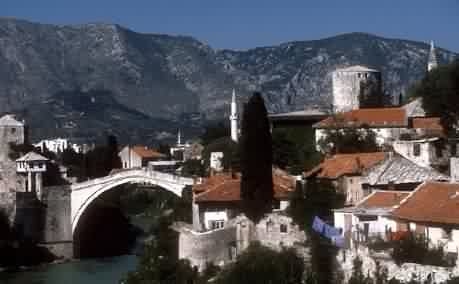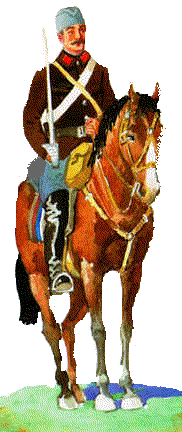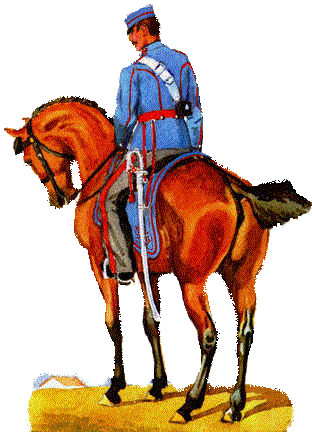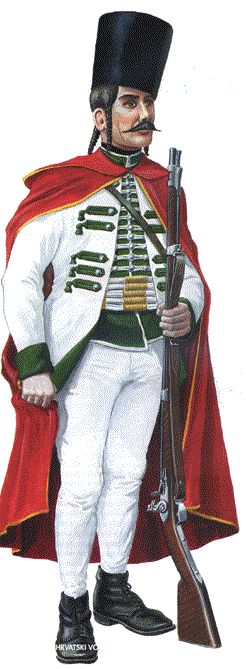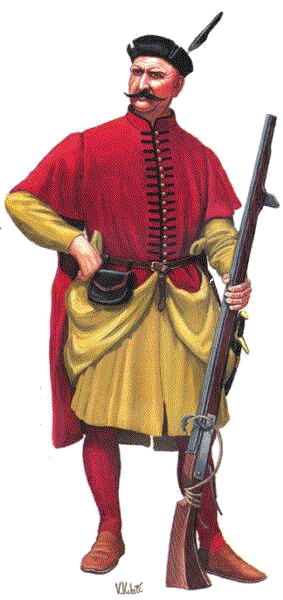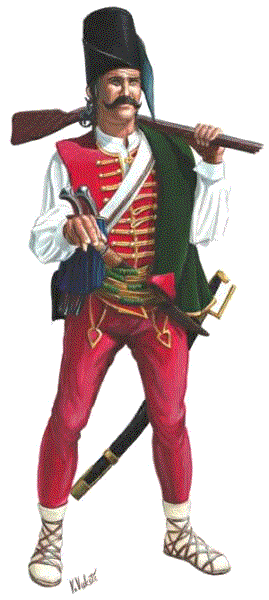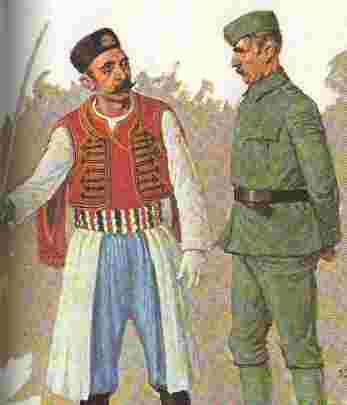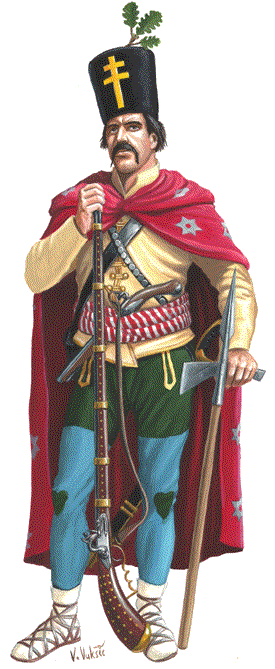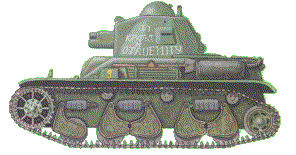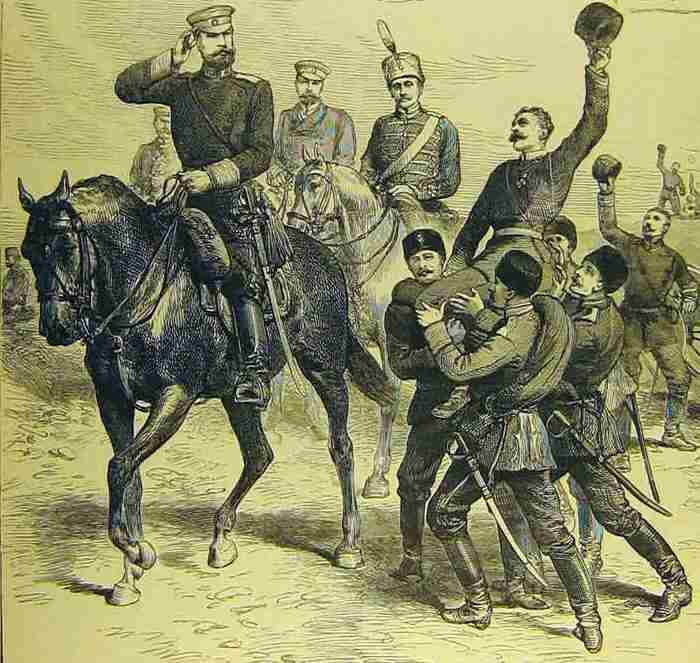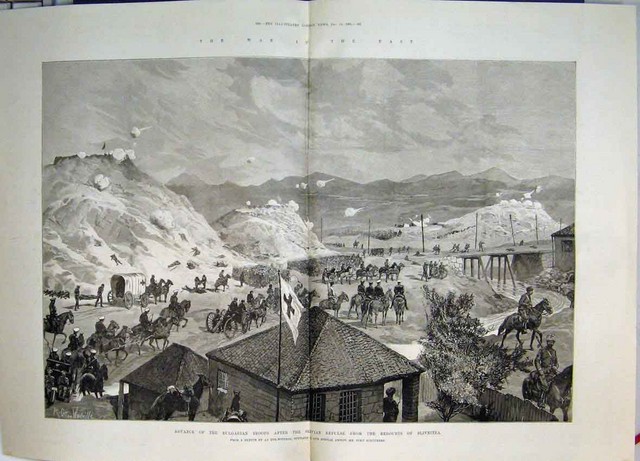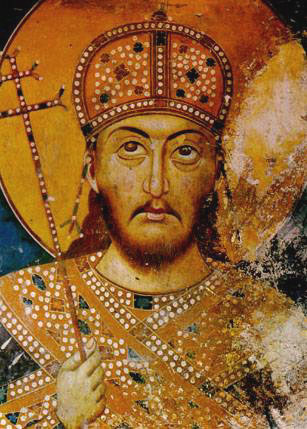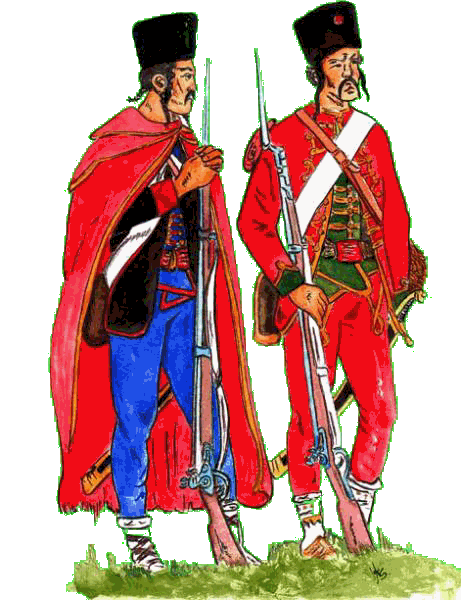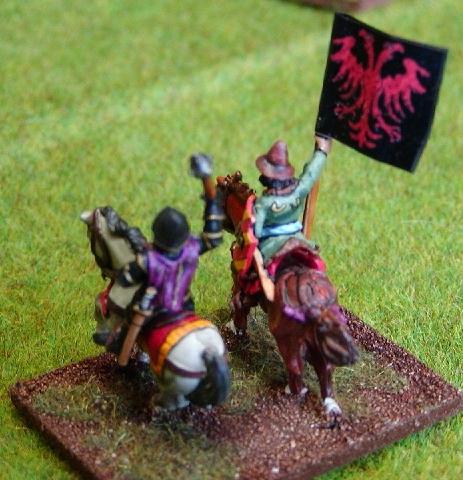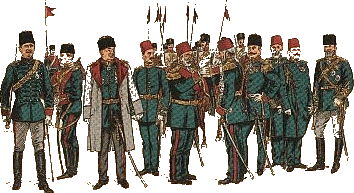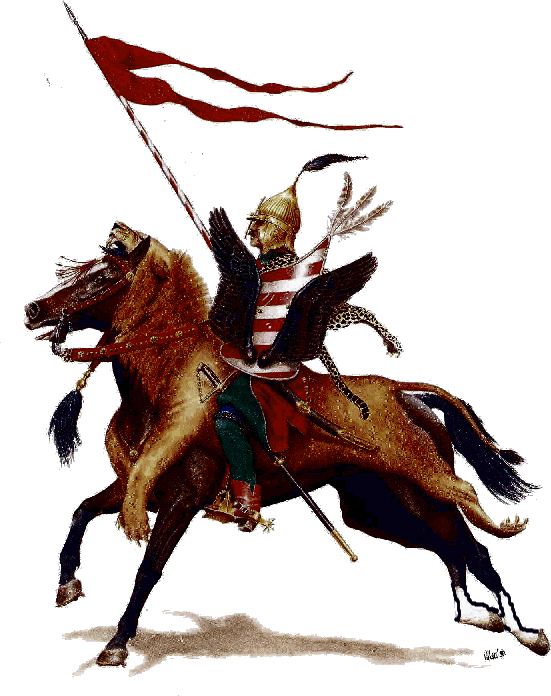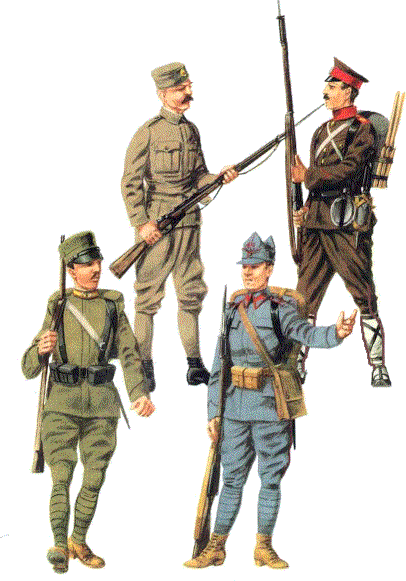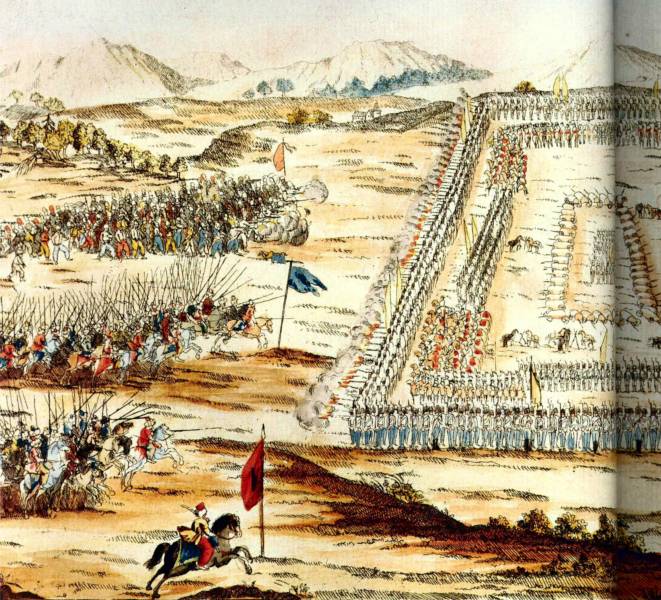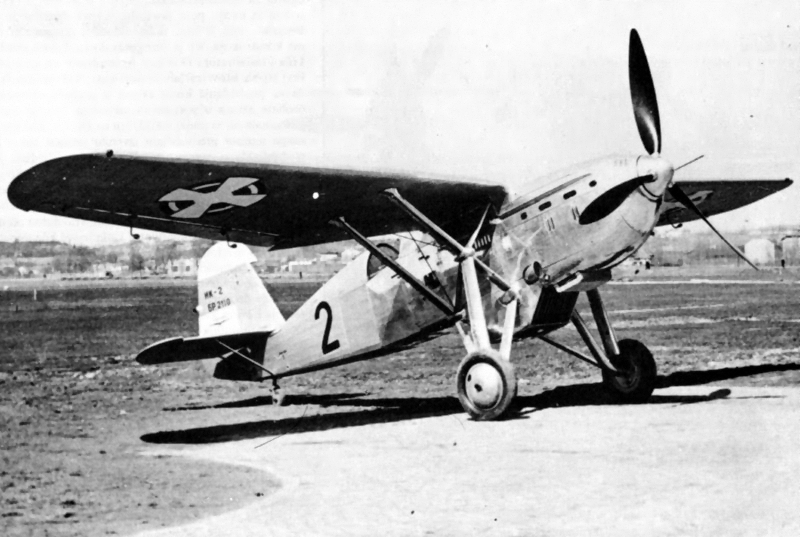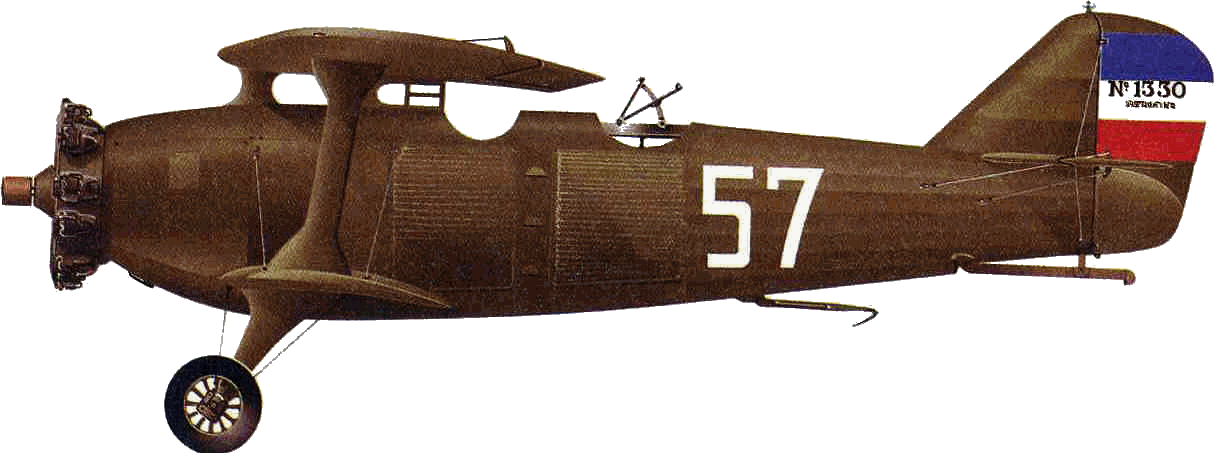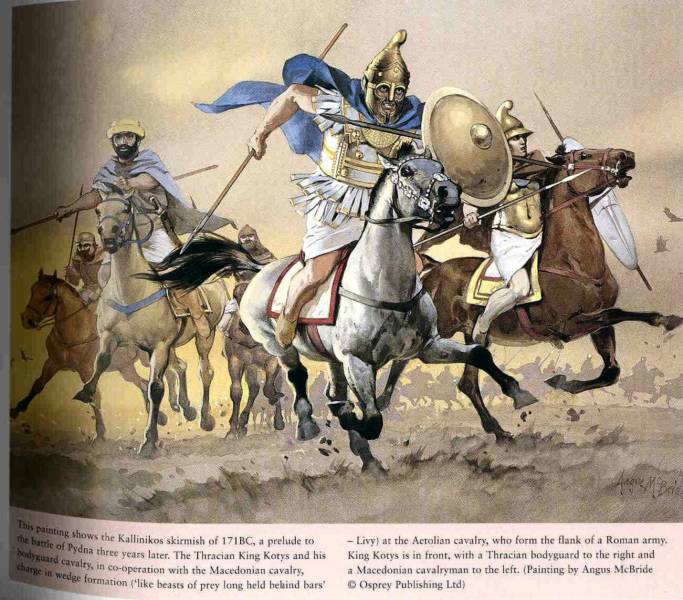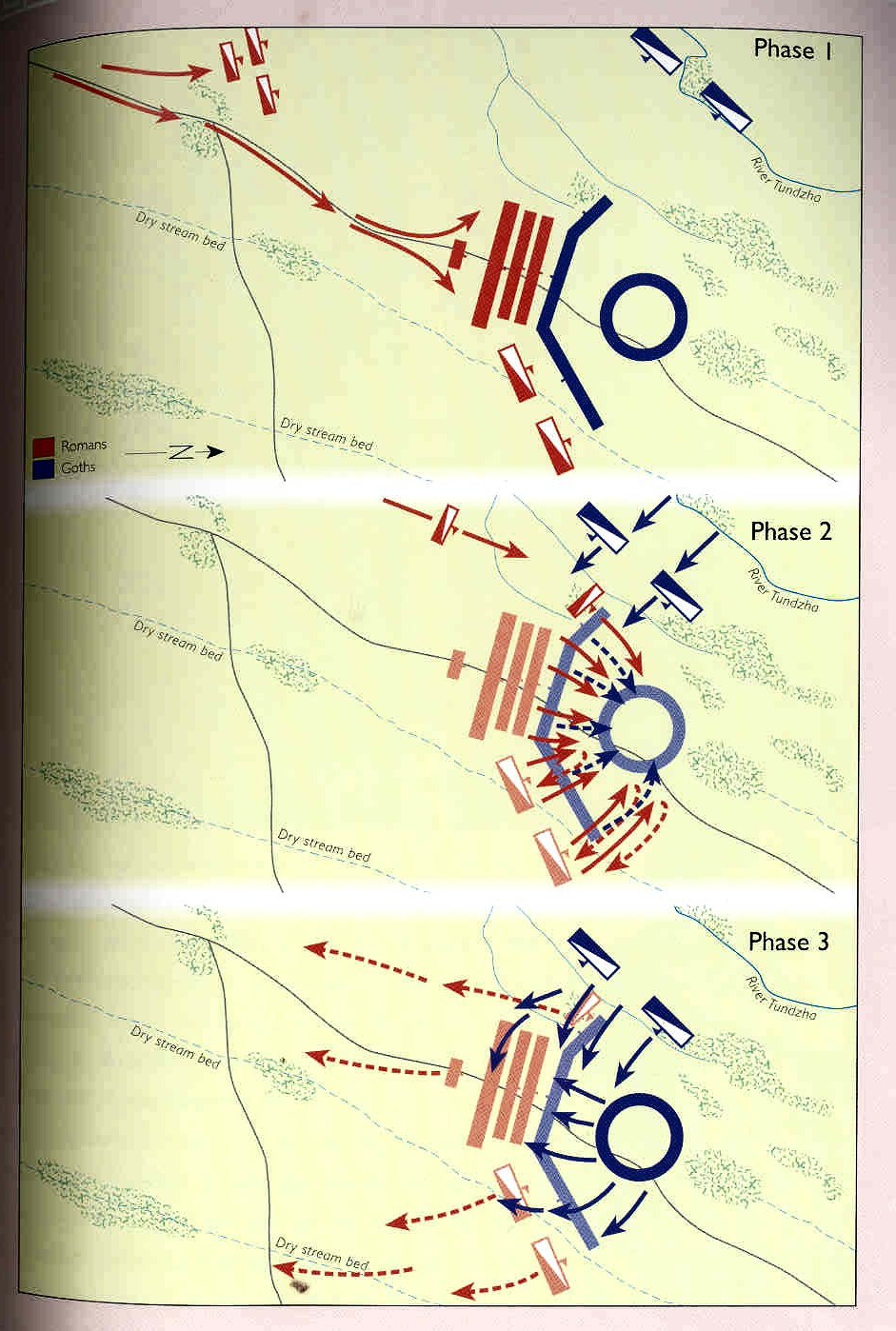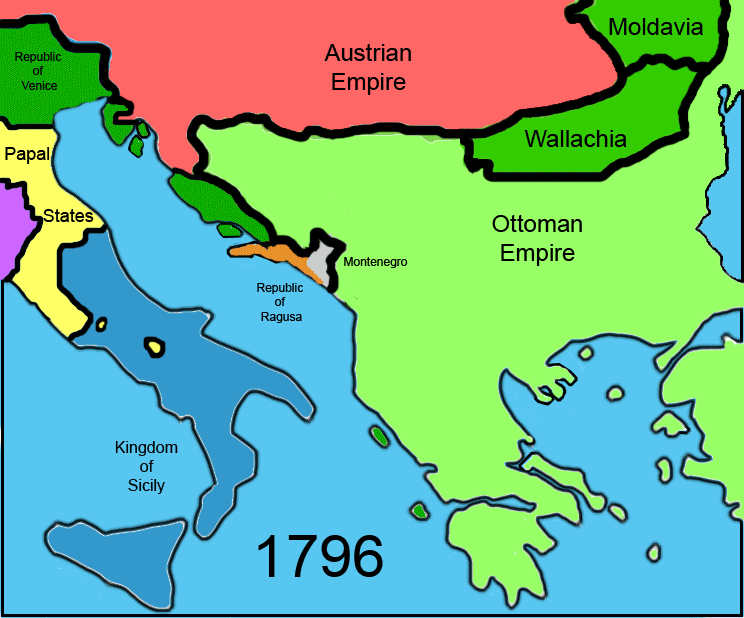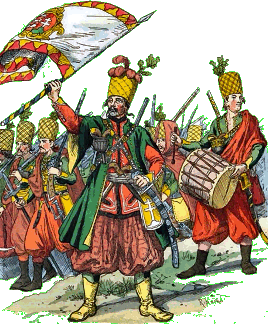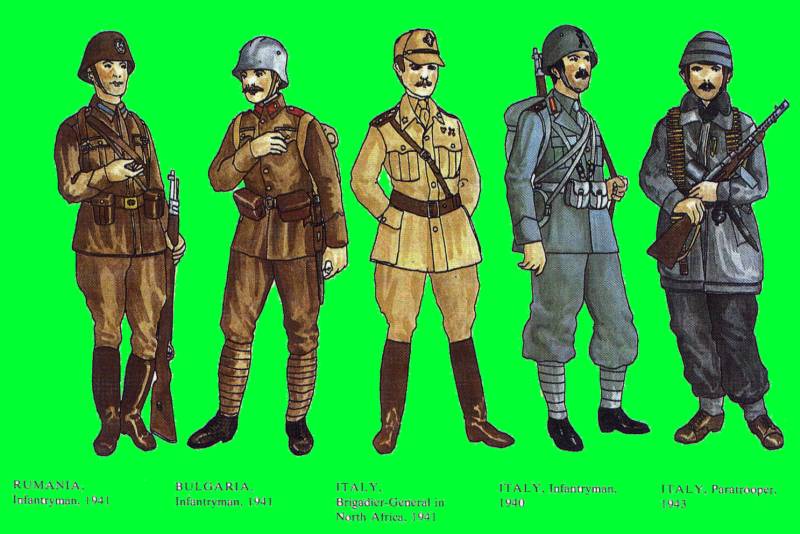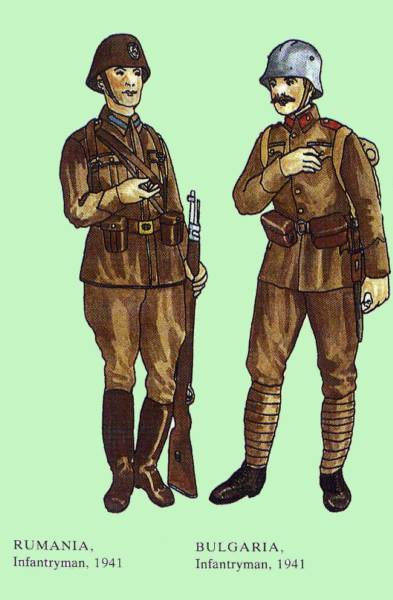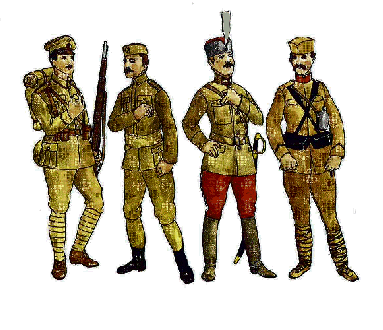The Uskok pirates of Dalmatia: two land battles
Klis 1596 The Uskoks often allied with Dalmatian nobles in attempts to liberate areas of Dalmatia from Ottoman rule, despite opposition from Venice and Dubrovnik. The most famous action took place on 7April 1596 when a force of 380 Uskoks supported the Split nobleman Ivan Alberti in the recapture of the Ottoman fortress of Klis. Forty Dalmatians from Split and Trogir with eighty Uskoks gained entry to the fortress by bribery. Before sunrise they admitted 300 Uskoks who overwhelmed the Ottoman garrison. A joint Uskok/Dalmatian garrison held the fortress while others sought to encourage a wider uprising. The Ottomans responded promptly and within a month 10,000 troops were besieging Klis. Far from supporting the Christian uprising Venice closed the borders and stopped any support or supplies reaching the Uskoks and their allies in Klis. Habsburg border troops from Karlovac with Uskok support commanded by General Lenkovic attempted an overland relief. However, the relief column was destroyed by a superior Ottoman force in Bosnia and the uprising collapsed. By 29 May the garrison abandoned Klis and fled back to Senj. Iz 1604 A typical large scale raiding action took place in December 1604 when a force of 400 Uskoks sailed south. After forcing their way past a Venetian fleet in the Velebit Channel they landed at Trogir. Half the Uskoks then crossed Venetian territory to raid the neighbouring Ottoman district. They captured 15000 cattle, ransoming some back to their owners and slaughtering the rest before returning with their booty to the boats. The Venetian commander with mainly Albanian troops cornered the Uskoks in a bay on the island of Iz. The Uskoks built a barricade on a hill above the beach and the Venetian fleet held off the beach until reinforcements arrived. On Christmas day a storm blew up and the following day the Venetians stormed ashore. When they reached the barricade the Uskoks had gone. During the night some Uskoks had tended fires, played musical instruments and built dummy guns. They rest had cut rollers greased with cattle fat and hauled their boats over the crest of the island to safety.
From: Dalmatia, esp around Split
Web Site: Balkan History.com
Battles of Plosnik 1388 and Kossovo (1389). Tuesday, 1/2/07, 9:11 AM
Troubles in Anatolia enabled Lazar to create a Balkan union which defeated an Ottoman army at Plosnik, on the Morava River in 1388. Murat returned to smash the Bulgarians detaching them from the Balkan union forces. After defeating Karaman in Anatolia he returned to the Balkans to face Lazar at Kossovo (1389). Here the Serbian army and allied Wallachian, Bosnian and Albanian troops fought off the first Ottoman attack but their counter attack failed to cross the Ottoman defensive ditch defended by archers and a few cannon. Murat¿s son Bayezid then counterattacked together with allied cavalry and the Serbian forces began to collapse. Murat was killed during the battle (probably by a deserter) and Prince Lazar and the other Serbian leaders were executed by Bayezid. The battle destroyed organised resistance to the Ottomans in the Balkans leaving only Hungary as a major enemy
Balkan Military History Tuesday, 1/2/07, 9:03 AM
Balkan Military History Has moved here
Web Site: BalkanHistory.com
Imperial Serbian Army circa 1356 Tuesday, 1/2/07, 9:01 AM
The core of the army consisted of noble cavalry (Vlastela) armed with lance and bow in the Byzantine syle. These were increasingly supplemented by western style knights. Mostly Germans in Dushan's reign. Light horse were provided by Hungarian, Cuman or even Tartar mercenaries. Later in the period Serbian lance armed Gusars took over this role. The infantry still included lightly armed javelin troops although the bow and crossbow became the most important infantry weapon in the 14th century. A western style charge by the armoured cavalry and knights was the main tactic with the infantry used to follow up.
From: Serbia
Web Site: Balkan Dave
Military history of Romania Wednesday, 12/27/06, 3:51 AM
Web Site: TWT
The Montenegrin army in WW1 Tuesday, 12/5/06, 8:13 AM
¿The army itself generally wore no uniform, with most men showing up on mobilization wearing a blend of civilian clothes accented with the occasional bandolier. Officers wore a uniform patterned on the tsarist Russian army of the time. Artillery, pulled by oxen was limited to about seventy pieces of a dozen different Italian and English makes dating to the 1850's. Montenegro was an ally of the Tsarist Russian Empire who donated most of the army's weapons. In 1902, 44,000 artillery short swords, 30,000 Berdan breech loading rifles, and 25,000 Smith & Wesson 44 caliber revolvers were given by the Russians to their Montenegrin allies. The fact that all of these weapons had been withdrawn by Imperial Russia as being obsolete was of little concern. A small shipment of more modern Mosin Nagant bolt action rifles was sent just before the war¿
Web Site: Suite 101
The Serbian army in WW1 Tuesday, 12/5/06, 8:10 AM
¿The regular Serbian soldier wore a uniform made from thin, airy grey-green cloth. The trousers were loose, tight from the knee, worn either with black or brown marching boots, or with the traditional woolen socks with the opanci moccassin-style shoes. A slung light brown bread bag and boxy German pattern leather ammunition pouches completed the marching uniform. The back pack was of a rucksack variety and pretty light, giving the Infantry men a standard load of only some 12kg (26 pounds), compared with, the Austro-Hungarian 25kg (55 pounds) per man, which increased the mobility of the Serb fighters. Uniform shortages however meant that the majority of reservists called to the colors simply wore their own clothing, only being issued the traditional Serb sajkaca cap. Reservists even had to carry their ammunition in their pockets as no pouches were available¿
Web Site: Suite 101
Historical maps of the Balkans Friday, 11/10/06, 7:11 AM
Wide variety of scales and dates.
Web Site: Texas Uni
The Austro-Hungarian military map series Friday, 10/27/06, 5:10 AM
The whole map series, published around 1910 prior to WW1, appears to be on this Magyar site ¿ ideal for Kriegsspiel gams and the like.
From: Central and south-eastern Europe (all)
Web Site: Lazarus
Balkan battles by region Tuesday, 6/20/06, 10:23 AM
Web Site: TWT
Some battles of Ancient Greece Wednesday, 3/22/06, 9:08 AM
Two Battles of Tanagra, in 457 BC and 426 BC; battles of Sybota ¿ Potidaea ¿ Chalcis ¿ Naupactus ¿ Tanagra ¿ Olpae ¿ Pylos ¿ Sphacteria ¿ Delium ¿ Amphipolis ¿ Mantinea ¿ Sicilian Expedition ¿ Syme ¿ Cynossema ¿ Cyzicus ¿ Notium ¿ Arginusae ¿ Aegospotami
Battles of the First Balkan War Wednesday, 3/22/06, 3:14 AM
battles of Giannitsa - Kumanovo - Kirk Kelesse - Pente Pigadia - Prilep - Lule-Burgas - Vevi - Bitola ¿ naval battles of Elli and Lemnos - Adrianople - Bizani
Web Site: Battles of the First Balkan War
The Battle of Abrittus or Forum Terebronii, July 1, 251AD. Monday, 3/20/06, 9:53 AM
After Decius' victory over Philippus Arabs at Verona, the senate made haste to confirm his election as emperor (AD 249). Decius maintained, perhaps quite truthfully, he had accepted the decision of his soldiers to make him emperor against his will. In AD 250 Decius was summoned to the Balkans by the news that a Gothic horde, supplemented by various non-Gothic tribes, had swarmed over the Danube and was ravaging the Roman province of Moesia. He found them besieging the fortress of Nicopolis. On his approach they instead went to attack the much more important stronghold of Philippopolis. Decius pursued them, the Goths then suddenly turned, surprised his army and defeated it, continuing onward to Philippopolis which fell after stubborn resistance. Decius reorganized his army, and blocked the passes, cutting off the Goths' escape from the Balkans. In the great battle of Forum Trebonii, the emperor's son was slain during the Roman assault, but the first line of King Cniva¿s Goths was shattered, so too the second. However, the front of the third line was covered by a morass in which the legions, pushing on to complete the victory became hopelessly bogged down, and eventually cut to pieces. Emperor Decius perished with his soldiers (AD 251), one of a select band of Roman Emperors who died likewise ¿ they were Constantine II , Decius, Gordian II, Herennius Etruscus, Julian, Julian the Apostate, Philip the Arab, and Valens [more were killed by their own troops; these were Aemilianus, Alexander Severus, Florianus, Maximinus Thrax, Julius Saturninus, Septimius, Trebonianus Gallus, and Volusianus]
From: Razgrad, in the swamps of the Bulgarian Dobrudja.
Web Site: Wikipedia
Byzantine battles Tuesday, 3/7/06, 4:36 AM
¿ Battle of Ad Decimum ¿ Battle of Adrianople (1254) ¿ Battle of Adrianople (1365) ¿ Battle of Ajnadayn ¿ Battle of Anchialus ¿ Battle of Anzen B ¿ Battle of Bathys Ryax C ¿ Battle of Callinicum ¿ Battle of Carthage (698) ¿ Fall of Constantinople D ¿ Battle of Dara Battle of Dorostolon D cont. ¿ Battle of Dyrrhachium (1081) K ¿ Battle of Kalavryai ¿ Battle of Kleidion ¿ Battle of the Olive Grove of Koundouros L ¿ Battle of Lalakaon M ¿ Battle of Manzikert ¿ Battle of Mons Lactarius ¿ Battle of Myriokephalon N ¿ Siege of Nicaea ¿ Battle of Nineveh (627) P ¿ Battle of Pelagonia ¿ Battle of Pliska S Battle of Sasireti S cont. ¿ Second Arab siege of Constantinople ¿ Battle of Sevastapol (692) ¿ Battle of Shirimni ¿ Battle of Sirmium ¿ Battle of Solachon ¿ Battle of Svindax ¿ Battle of Syllaeum T ¿ Battle of Taginae ¿ Battle of Ticameron V ¿ Battle of Versinikia ¿ Battle of the Volturnus Y ¿ Battle of Yarmouk
From: Istanbul
Web Site: Wikipedia
The Battle of Nedao, 454 AD Wednesday, 7/20/05, 8:45 AM
¿After the death of Attila the Hun, allied forces of the Germanic subject peoples under the leadership of Ardaric, king of the Gepids, defeated the Hunnic forces of the numerous sons of Attila, who had struggled for supremacy after Attila's death and intended to divide the allies among them like slaves, according to the 6th century historian Jordanes.: And so the bravest nations tore themselves to pieces. For then, I think, must have occurred a most remarkable spectacle, where one might see the Goths fighting with pikes, the Gepidae raging with the sword, the Rugi breaking off the spears in their own wounds, the Suavi fighting on foot, the Huns with bows, the Alani drawing up a battle-line of heavy- armed and the Heruli of light-armed warriors. (Origins and History of the Goths, l.261). Hunnic dominance in Central and Eastern Europe was broken as a result. The victors were granted lands by the Roman emperor, the Gepidae in Dacia, now outside the Empire, "demanding of the Roman Empire nothing more than peace and an annual gift as a pledge of their friendly alliance. This the Emperor freely granted at the time, and to this day that race receives its customary gifts from the Roman Emperor." Thus the victorious Ardaric and the Gepidae passed out of the arena of Roman history. The Ostrogoths received Roman lands in Pannonia, and their future remained bound with the career of the Late Empire. Jordanes relates that the Sciri and the Sadagarii and certain of the Alani with their leader, Candac, received Scythia Minor and Lower Moesia. The Rugi, however, and some other races asked that they might inhabit Bizye and Arcadiopolis. Hernac, the younger son of Attila, with his followers, chose a home in the most distant part of Lesser Scythia. Emnetzur and Ultzindur, kinsmen of his, won Oescus and Utus and Almus in Dacia on the bank of the Danube, and many of the Huns, then swarming everywhere, settled in Romania. After the victory at the Nedao, the Gepids finally won a place to settle in the Carpathian Mountains; however, not long after the battle at Nedao the old rivalry between the Gepids and the Ostrogoths spurred up again and they were driven out of their homeland in 504 by Theodoric the Great, the son of Theodemir¿
From: On the Nedava, a tributary of the Sava, in Pannonia
Web Site: www.yotor.com
Battle of Lule-Burgas 1912 Wednesday, 3/9/05, 9:38 AM
The major action of the 1912 Balkan War. ¿The Bulgarian guns were in greater numbers and better served, and they had an inexhaustible supply of ammunition. Not so the Turks. In consternation, in rage, in despair, the Turkish artillery officers saw their ammunition dwindling and giving out at a time when they needed it most: when the enemy's shells were bursting continuously upon their positions, when the enemy's infantry were exposing themselves on the ridges, and when the Bulgarian soldiers made wild rushes, advancing from point to point, in spite of their heavy losses in dead and wounded. There were Turkish officers and soldiers who stood with folded arms by the limber of guns that could no longer return the enemy's fire, until to a man they were wiped out by the scattered shells. The frantic messages carried to the commander-in-chief notifying him of this lack of ammunition passed unheeded, because the supply was exhausted. Abdullah Pasha was a sad man that day, when from one of the heights he looked down upon his scattered army corps and saw how gradually their fire was silenced. Now on his right wing and his left his legions were pressed back until they wavered and broke. And now, with an overwhelming power and irresistible spirit of attack, the Bulgarians cut the railway line, scattered his squadrons of cavalry, broke through his various units, and bore down upon his rear-guard holding the town of Lule- Burgas¿
From: Thrace?
Web Site: Halsall at Fordham
Revolt of the Bogomil Heretics 1087 Tuesday, 2/1/05, 8:18 AM
The heretics, supported by the Patzinaks and Cumans, were able to defeat the Byzantine Emperor Alexius and a large army (battle of Drystra, or Dorostolon, 1087). The Cumans then ravaged the entire eastern Balkan region as far as Constantinople until Alexius bought them off, took them into imperial service, and used them to annihilate the Patzinaks (Battle of Leburnion 1091).
From: Thrace and Bulgaria.
some battles in Greece Thursday, 10/21/04, 9:46 AM
Boeotia Thebes Bc86 Chaeronea Sulla defeats the Hellenic Mithridates of Pontus Greece Boeotia Thebes Bc86 Orchomenus Sulla defeats the Hellenic Mithridates of Pontus
From: Greece
more Balkan battles Thursday, 10/21/04, 9:36 AM
Balkans Bulgaria Edirne 1230 Klokotnitsa Balkans Macedonia Salonica 1014 Strymon Balkans Romania Dobruja 0251 Abrittus Emperor Decius defeated and killed by Goths Balkans Serbia 0268 Naissus Goths defeated by Gallienus Balkans Serbia Vincovc 0316 Cibalae Constantine defeats Licinius
Battle of Dorostol 971 Saturday, 2/21/04, 6:36 AM
fought on the Danube by Svyatoslav of Kiev - he may originally have been a Varangian Swedish Viking, who ascended the rivers leading into Russia from the Baltic, and founded principalities at Kiev and other places. Some of his contemporaries even arrived at Constantinople, forming the Varangian Guard of the Byzantine Empire.
Albanian history Monday, 2/2/04, 5:11 AM
see also the SLAVOPHILIA site for other Balkan Slav nations.
From: Albania, Kosovo, Macedonia, etc
Web Site: Albanian.com
the Despot of Epirus, Theodore Dukas Thursday, 7/17/03, 12:31 PM
In 1214, Theodore Dukas Angelus, nephew of the Byzantine Emperor Michael, became Despot of Epirus. He began the work of expansion at the expense of the Latins and Bulgars, taking Durazzo and Corfu from the Venetians (1214). He took Macedonia (1215) and Thessalonica after the Battle of Serres 1221. Dukas was only halted by the Bulgarians at Klokonista 1230
From: western Greece
Web Site: the Despot of Epirus, Theodore Dukas
The wars and battles of Greece Friday, 7/11/03, 11:04 AM
From: Hellas
Web Site: The wars and battles of Greece
Battle of Pelium. 335 BC Friday, 7/11/03, 5:50 AM
the Balkan battle between Alexander the Great's Macedonian army and the rebellious Illyrians under the rule of Clitus
From: Macedonia
Web Site: Battle of Pelium. 335 BC
Battle of Lyginus - 336 BC Friday, 7/11/03, 5:43 AM
Alexander the Great's battle between his Macedonian forces and those of the Triballians under the rule of Glaucias.
From: Thrace?
Web Site: Battle of Lyginus - 336 BC
conflicts in Greece Wednesday, 7/9/03, 9:42 AM
a comprehensive list, sorted by Greek regions
From: Greece
Web Site: conflicts in Greece
The Crusade v Byzantium 1204 Tuesday, 7/8/03, 9:57 AM
The Fourth Crusaders were persuaded by Venice to capture this centre of Christianity instead of marching against the Moslems!!. They thereafter captured the whole of Greece for themselves.
From: Istanbul
Web Site: Holy Order of Knights Templar
Aetolia Monday, 6/30/03, 9:56 AM
Aetolia is a division of Greece, bounded on the west by Acarnania, from which it was separated by the river Achelous; on the north by Epirus and Thessaly; on the east by the Ozolian Locrians; and on the south by the entrance to the Corinthian Gulf. It was divided into two parts: Old Aetolia, from the Achelous to the Evenus and Calydon; and New Aetolia, or the Acquired, from the Evenus and Calydon to the Ozolian Locrians. On the coast the country is level and fruitful, but in the interior mountainous and unproductive. The mountains contained many wild beasts, and were celebrated in Greek mythology for the hunt of the Calydonian Boar. The country was originally inhabited by Curetes and Leleges, but was at an early period colonized by Greeks from Elis, led by the mythical Aetolus.
From: Greece
War in the Balkans Monday, 6/30/03, 6:57 AM
Looks interesting, tho the imposing introductory map disappoints by not allowing clicking on particular countries!!
From: Balkans incl Greece and Turkey
Web Site: Kozlich and Watson
An ehistory of Greece in 22 chapters Monday, 6/30/03, 3:28 AM
Web Site: Bookrags
Greco ¿ Turk war of 1897 Monday, 6/30/03, 3:20 AM
This war, also called the Thirty Days' War, took place against a background of growing Greek concern over conditions in Crete, which was under Turkish domination and where relations between the Christians and their Muslim rulers had been deteriorating steadily. The outbreak in 1896 of rebellion on Crete, fomented in part by the secret Greek nationalistic society called Ethniki Etairia, appeared to present Greece with an opportunity to annex the island. By the beginning of 1897, large consignments of arms had been sent to Crete from Greece. On January 21 the Greek fleet was mobilized, and in early February Greek troops landed on the island, and union with Greece was proclaimed. The following month, however, the European powers imposed a blockade upon Greece to prevent assistance being sent from the mainland to the island. They took this step to prevent the disturbance from spreading to the Balkans. Thwarted in their attempt to assist their compatriots in Crete, the Greeks sent an illprepared force, commanded by Prince Constantine, to attack the Turks in Thessaly (April). However, two defeats there were followed by a third at Tyrvanos, at the hands of the Turkish army, which had recently been reorganized under German supervision. The Greeks then yielded to pressure from the European powers, withdrew their troops from Crete, and accepted an armistice on the mainland (May 20, 1897). A peace treaty, concluded on December 4, compelled Greece to pay the Turks an indemnity, to accept an international financial commission that would control Greek finances, and to yield some territory in Thessaly to Turkey. Subsequently, the Turkish troops also left Crete, which had been made an international protectorate, and an autonomous government under Prince George, the second son of the Greek king, was formed there (1898). Crete was finally ceded to Greece by the Treaty of London (1913), which ended the First Balkan War.
From: Thessaly
Turkish army of WW1 Thursday, 6/26/03, 12:11 PM
this v detailed site includes both land and sea OOBs
From: Turkey
Web Site: Turkish army of WW1
Classical Greek Battles Wednesday, 6/11/03, 5:13 AM
HERODOTOS 6.29.1 Malene 493 A long time 6.113 Marathon 490 A long time 7.167 Himera 480 From dawn until late evening 9.62.2 67 Plataiai 479 a long time 9.102.3 Mykale 479 Persians stood their ground for a long time 9.119.2 Aigospotamoi 479 Persians defended themselves for a long time THUCYDIDES 3.74.3 Kerkyra 427 Fighting in the city ceased at night 3.97.3-3.98.1 Aigition 426 Hoplites won out from long engagement against light armed 3.108.3 Olpai 426/5 Ended late in day 4.35.3 Sphakteria 425 Most of day 4.44.1 Solygeia 425 Neither side yielded for a long time 4.72.3 Megara 424 Hippomachia 4.93.1; 4.96.8 Delion 424/3 Started late, 4.96.8 stopped at night 4.134.2 Laodokeion 423/2 Issued undecided. Terminated by night 6.70.1 Syrakuse 415 Hand-to-hand for a long time XENOPHON Hell. 1.2.17 Abydos 409 Pursuit until darkness 6.4.8 Leuktra 371 Began af ter midday meal 7.2.12 Phleious 366 Skirmishes for most of day DIODOROS 11.83.1 Oinophyta 457 Whole day 13.51.4 Kyzikos 410 Long fight before line was broken 14.12.7 Poros 403 Long struggle 14.33.2 Mounychia 401 Long struggle 14.82.9 Naryx 395 Protracted battle 15.34.2 Thebes 377 Protracted battle 16.39 5 Orneai 352 Stubborn, indecisive battle 16.46.9 Pelousion 350/49 Indecisive battle for whole day, broke off at night 16.86.1 Chaironeia 338 Deployed at dawn, hotly contested for a long time 17.11.5 Thebes 335 Evenly balanced for a long time ARRIAN An. 3.14.3 Gaugamela 331 Hand-to- hand for some little time POLYBIOS 4.12.7 Kaphyai 219 Lengthy struggle 18.19.12 Pherai 197 Skirmished for a long time PLUTARCH Aem. 22 Pydna 168 One hour
From: Greece
Web Site: The Ancient Greek Historians
Hoplite shield devices Wednesday, 6/11/03, 3:53 AM
Web Site: Nick Sekunda
Balkan military history Thursday, 5/22/03, 10:15 AM
Web Site: Keele University
Military affairs of ancient Greece and Macedonia Thursday, 5/22/03, 9:44 AM
includes sections on: Achaean League | Aetolian League | Sparta | Greece and Macedonia after the Second Punic War Macedonia | Philip V of Macedon | First Macedonian War (211-205 BC) | Second Macedonian War (200-196 BC) | Battle of Cynocephalae, 197 BC | Third Macedonian War (171-168 BC) | Battle of Pydna, 168 BC | The Fourth Macedonian War (149-148 BC)
From: Greece and Macedonia
Web Site: Barca
Warfare in the Hellenistic Greek world Wednesday, 5/14/03, 8:42 AM
From: Greece and Asia Minor
Web Site: Warfare in the Hellenistic Greek world
Warfare in Hungary and Croatia (1350 AD to 1500 AD ) Monday, 4/28/03, 7:05 AM
Includes: Military art of Croatia, very good illustrations from Croatia's history Battle of Kossovopolje (included maps of the battle) Battle of Varna (included maps of the battle) Hungarian Tactics and Battles page added, Covers battles up until 1443.
Web Site: Matt Haywood.
History of Albania Monday, 12/16/02, 5:33 AM
The region on the Western part of the Balkan peninsula known as Albania or Shqiperi [land of eagles] was colonized in the 7th century BC by the Greeks who had an important cultural influence on the population for the next several centuries. One of Europe's smallest countries, it has a 225 mile coastline on the Adriatic and Ionian seas and is bounded in the north and east by what was Yugoslavia and on the southeast by Greece. The Albanians are made up of two main sub-groups the Ghegs in the north and the Tosks in the south. Their languages are mutually intelligible. In 350 BC there emerged an independent kingdom known as Illyria in the northern part of the region. In 168 BC the Romans conquered both Illyria and Epirus to the south. When the Roman Empire split into Western (Rome) and Eastern (Byzantium), provinces in the fourth century AD, both Illyria, which later became known as Albania, and Epirus became a part of what became the Byzantine Empire. Byzantine control was weak, however, and in the next centuries parts of Albania were occupied by the Goths, Bulgars, Slavs, Serbs, Normans and Angevins. In the XIIIth century they came under the Byzantine Greek Despotate of Epirus then briefly under the Serene Republic of Venice in the last part of the XIVth century and, eventually, under Turkish domination from the XVth to the XXth
From: Adriatic coast
Web Site: History of Albania
The naval wars of ancient Rhodes Tuesday, 11/19/02, 9:49 AM
Confronted by the full power of three large empires, the Rhodian navy faced and performed the herculean task of meeting all the demands the new wars, new enemies, and new allies posed upon it
Web Site: The naval wars of ancient Rhodes
Military history of Serbia Wednesday, 10/30/02, 12:46 PM
see also Serb uniforms at http://suc.suc.org/exhibitions/Uniforms/index.html#on e and another site named '"UNIFORMS of THE SERBIAN ARMY"'
Web Site: Military history of Serbia
The war in the Balkans 1994 Wednesday, 10/30/02, 12:32 PM
Web Site: The war in the Balkans 1994
Battle of Plevna 1877 Wednesday, 10/30/02, 11:46 AM
prior to the Russo-Turkish War of 1877 Plevna was a small and unknown town without fortifications. It became celebrated throughout the world as the scene of Osman Pasha's victories and his five month's defence of the entrenched camp which he constructed around the town, a defence which upset the Russians' plans and induced them to devote their whole energies to its capture.
From: Danube area
Web Site: Battle of Plevna 1877
Byzantine Military History Wednesday, 10/30/02, 10:32 AM
From: Istanbul & around!
Web Site: Byzantine Military History
Balkan military history Wednesday, 10/30/02, 9:33 AM
Apart from a chronology and detailed historical essays, the site features the following articles as at Wednesday, October 30, 2002: The Ottoman army of Rumeli in 1826. The battle for Kajmakcalan, WW1 Macedonian campaign. The Siege of Klis 1537. War Flying in Macedonia. Air warfare on the Struma front 1915-18. Blunder in the Mountains. The Italian invasion of Greece 1940 The Battle of Kumanovo 1912 with photographs of the battlefield today. The Battle of Slivnitsa 1885 - Serbo-Bulgarian War Prince Eugene in Eastern Europe 1683 - 1697 Castles on the Danube. A pictorial trip down the River Danube. The Uskoks of Senj. DBR army list 1532-1617 The Serbo-Turkish War 1876 The Lion of Jannina. Ali Pasha 1741-1822 The Romanian Army of the Russo-Turkish War 1877-78 Bosnia and the Austro-Turkish War 1737-9 - "execrated infidel wretches!" The Retreat from Serbia Dec. 1915 - Actions at Kosturino
Web Site: Balkan Dave
Polybius (c.200-after 118 BCE): Monday, 10/21/02, 9:47 AM
In former times the Macedonian tactics proved themselves by experience capable of conquering those of Asia and Greece; while the Roman tactics sufficed to conquer the nations of Africa and all those of Western Europe; and since in our own day there have been numerous opportunities of comparing the men as well as their tactics, it will be, I think, a useful and worthy task to investigate their differences, and discover why it is that the Romans conquer and carry off the palm from their enemies in the operations of war: that we may not put it all down to Fortune, and congratulate them on their good luck, as the thoughtless of mankind do; but, from a knowledge of the true causes, may give their leaders the tribute of praise and admiration which they deserve.
From: Rome
Web Site: The Roman Maniple vs. The Macedonian Phalanx
Serbian Military Uniforms 1808-1918 Wednesday, 5/15/02, 12:02 PM
A uniformed Serbian militia is mentioned at the end of the seventeenth century after the siege of Vienna in 1683, but no details are known of its dress. It can be supposed that it derived from national costumes like the uniform introduced at the end of the first half of the eighteenth century.
From: Serbia
Web Site: Serbian Military Uniforms 1808-1918
Serbian history Wednesday, 5/15/02, 12:00 PM
From: the Balkans
Web Site: Serbian history
Thracian history Friday, 5/10/02, 8:33 AM
For two thousand years, possibly a million Thracians lived in the area now covered by Rumania, Bulgaria, northeastern Greece, and northwestern Turkey. They never progressed beyond a tribal Homeric society, and were constantly at war with one another and their neighbours. They were renowned for their love of song, music, dance, colourful clothing, wine, religion, and war. They produced increadibly beautiful and expensive art. Orpheus, Ares (the god of war), and Boreas (the god of the destructive north wind) were all Thracian. Their warlike temper put them in constant demand as (sometimes highly paid) mercenaries by all the Mediterranean powers. They annihilated several Greek armies sent on colonisation attempts, and continually gave the coastal Greek cities a lot of trouble, until Athenian machinations split the Odrysian kingdom, allowing Philip of Macedon to overwhelm them. Until 46 AD (when Thrace became a Roman province) the Greeks and Romans lived in fear of a dark Thracian cloud descending from the north, devastating civilisation in the Balkans.
From: Thrace
Web Site: Thracian history
Velimir Vuksic Friday, 5/3/02, 7:19 AM
a fantastic site with 100 superb uniform illustrations and much else besides. If I ever start a best site competition, this will win it hands down!!.
From: Croatia
Web Site: Croatian uniforms through the ages

